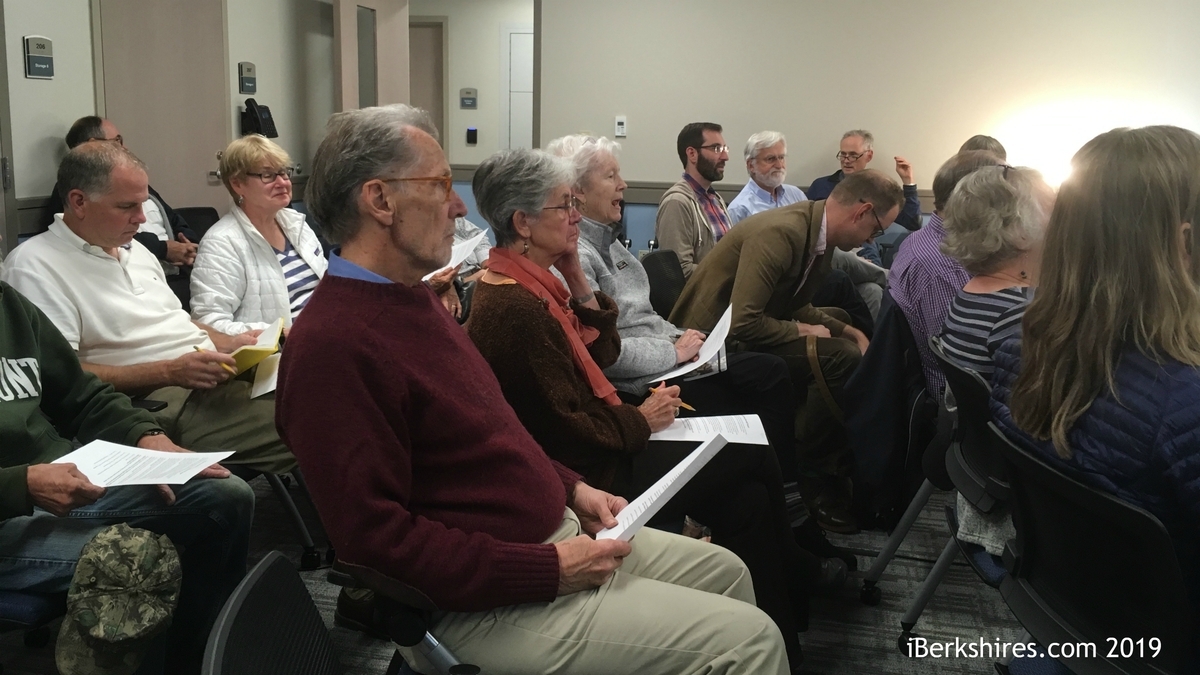Williamstown Gathers Community Input on Street LightsBy Stephen Dravis, iBerkshires Staff
01:30AM / Monday, September 23, 2019 | |
 Part of the crowd at Wednesday's listening session. Some sample light fixtures are illuminated at right. Part of the crowd at Wednesday's listening session. Some sample light fixtures are illuminated at right. |

Stephanie Boyd helps lead Wednesday's session.
WILLIAMSTOWN, Mass. — About two dozen residents Wednesday turned out for a forum to discuss plans to replace the town's street lighting with more energy efficient LED fixtures.
The consensus that emerged from the listening session was pretty clear: Those in attendance want to see a lighting plan that utilizes warmer temperature fixtures and reduces spillover lighting.
"More lighting is not better," Charles Fulco of the International Dark Sky Association said, speaking for many in the room. "Less lighting used properly is better."
The town is at a crossroads when it comes to how public roads are illuminated.
Earlier this year, the Williamstown Fire District, which is responsible for street lights, backed out of an agreement with National Grid to replace all the town's incandescent street lamps with LED fixtures in a move that would have saved energy and money but which generated backlash from residents who objected to the 4,000 degree Kelvin fixtures available from the utility.
National Grid, which owns the light fixtures, only can offer the 4,000 Kelvin replacements, which many in town argue are too harsh and create glare that would be a nuisance to residents.
Instead, the Fire District, in cooperation with town hall and the volunteer Williamstown COOL Committee is exploring the possibility of buying and installing its own LED fixtures on the poles, as about four dozen municipalities have done in cooperation with the Metropolitan Area Planning Council.
To that end, the town and district are engaging California-based Tanko Lighting to do an inventory of the town's current street lights and an assessment of its needs.
Wednesday's listening session in the meeting room at the police station was designed to gather thoughts from the community that will inform Tanko's lighting audit, according to the COOL Committee's Nancy Nylen.
"The COOL [Carbon Dioxide Lowering] Committee get involved with projects to reduce carbon usage," Nylen said. "But we also are looking at promoting sustainable practices. … We think about the triangle of sustainability: environment, economy and people and their quality of life."
Time and again, the residents at Wednesday's meeting said that their own quality of life already was negatively impacted by an abundance of street lights.
"I live near the intersection of White Oaks and Ballou Lane, where there used to be a school but there isn't anymore" Laura Christensen said. "Lights go up White Oaks and Ballou in a way that, to me, seems unnecessary."
"I live on Meadow Street," Elaine Murphy said. "There's one light, and in the summer, it's fine. There's a tree over it, and it's shaded downward. In the winter, I have to put cardboard over the windows where I sleep."
Jefferson Strait of Fort Hoosac Place joined many in saying he was happy the town was addressing the lighting issue but wanted to make sure that it takes a comprehensive approach to the question.
"LED lights are far more efficient than the lights we currently have," Strait said. "I think what we're doing tonight also is important because that while we have this opportunity to rethink lighting in town, it's important not to slap LEDs in the same places and the same orientation where we already have lights.
"One good property of LEDs is that the LED chip only emits light in one direction. That makes it possible for the light to be directed far more effectively."
Several residents -- and Fulco, who lives in Otis -- pointed to studies that link light pollution to detrimental effects on human health through disrupted sleep cycles.
Resident Charles Bonenti reminded all that while people have options to block light out of their sleeping spaces, wildlife do not, and there is evidence to suggest manmade light is impacting the circadian rhythms of animals.
At least one resident cautioned against the town going too far the other way with the project and reducing lighting in areas, like Main Street (Route 2), where lighting is needed to protect pedestrians crossing from end of the Williams College campus to the other.
Stephanie Boyd of the COOL Committee answered that the Tanko Lighting audit would seek to balance safety needs against residents' desire to reduce lighting overall.
Town Manager Jason Hoch addressed the Main Street crossings issue.
"If you've been down Main Street recently, you've noticed a preponderance of orange cones," Hoch said. "There will be more of the push button [pedestrian] beacons, which I realize some people like and some people hate. … They will be at all the crossings."
The town first tried out the pedestrian-activated warning signal for motorists at the crossing near the ‘62 Center for Theatre and Dance.
Hoch attended Wednesday's forum to hear the thoughts of residents, as did Fire Chief Craig Pedercini and Douglas Schlaefer, the sustainability project manager at Williams College, which has its own street lights around its campus on private land.
Organizers said it will take several months before they have a lighting plan in place to put before the town, and part of that planning process will include demonstration lights to show how the fixtures under consideration perform in the real world.
In the meantime, the town will continue to gather input from residents. More information and a portal to leave comments is available through the town's website, here. | 
